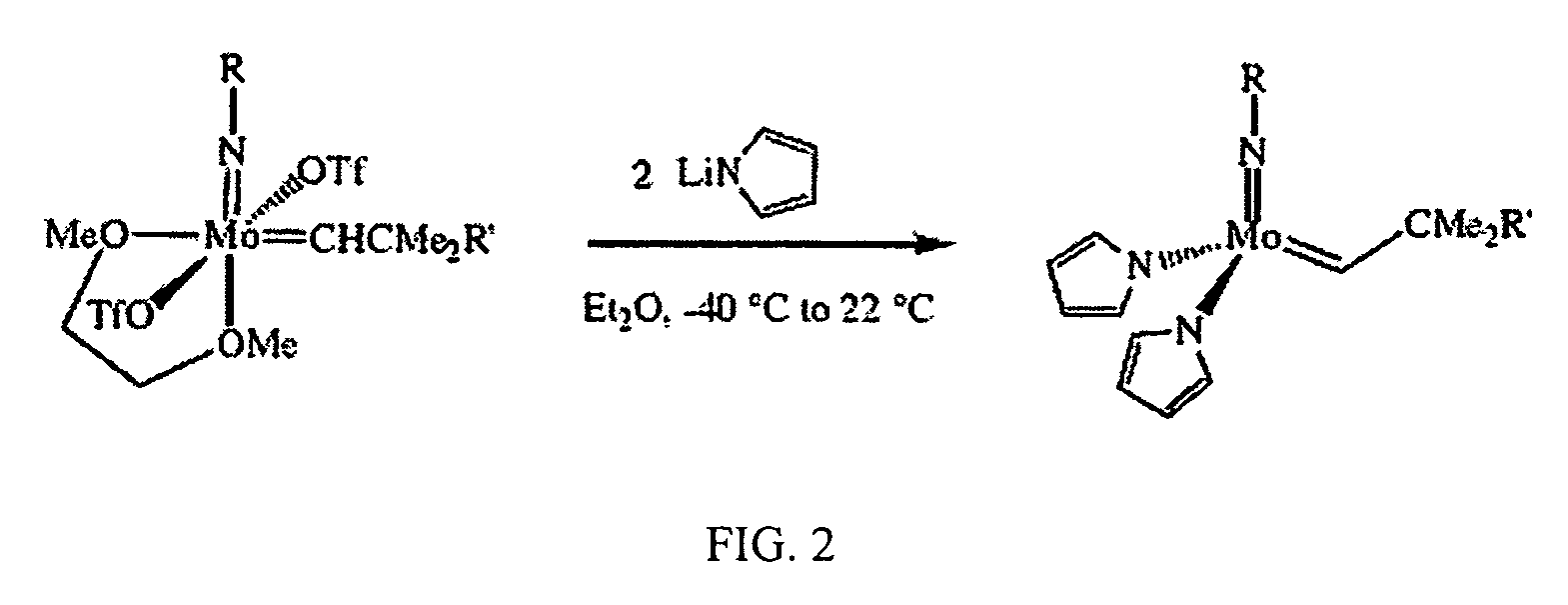Olefin metathesis catalysts and related methods
a technology of olefin metathesis and catalyst, which is applied in the direction of organic compound/hydride/coordination complex catalyst, physical/chemical process catalyst, organic compound/hydride catalyst, etc., can solve the problems of slow substitution or replacement of ligands bound to organometallic catalyst, and affecting the performance of catalys
- Summary
- Abstract
- Description
- Claims
- Application Information
AI Technical Summary
Benefits of technology
Problems solved by technology
Method used
Image
Examples
example 1
[0058]All complexes were handled using standard Schlenk techniques or in a Vacuum Atmospheres glove box under an argon or dinitrogen atmosphere. All solvents were dried, degassed, and stored over activated molecular sieves in a dinitrogen-filled glovebox. Pyrrole was distilled from CaH2 in an inert atmosphere and lithium pyrrolide was prepared using published procedures. Mo(N-2,6-i-Pr2C6H3)(CHCMe2Ph)(OTf)2DME, Mo(NAd)(CHR)(OTf)2(DME), and Mo(N-2,6-Br2-4-MeC6H2)(CHCMe3)(OTf)2(DME) were synthesized by published procedures. Elemental analyses were performed by Desert Analytics, Tucson, Ariz. Little or no competitive deprotonation of the alkylidene to give an alkylidyne complex was observed. The compounds were sensitive to air and moisture and could be recrystallized readily from toluene or mixtures of pentane and ether.
example 2
Synthesis of Mo(N-2,6-i-Pr2C6H3)(CHCMe3)(NC4H4)2
[0059]The following procedure was used to prepare the title compound. To a −35° C. solution of 0.193 g (0.27 mmol) Mo(NAr)(CHCMe3)(OTf)2(DME) in 4 mL diethyl ether was added 38.6 mg (0.53 mmol) of LiNC4H4 as a solid in one portion. The mixture was stirred at room temperature for 1 hour, then all volatiles were removed in vacuo. The resulting brown powder was extracted with 5 mL of toluene and the solution was filtered through celite. The celite was washed with toluene (1 mL) and the resulting solution was taken to dryness in vacuo. The product was recrystallized from mixtures of pentane / toluene or pure toluene at −35° C. as a toluene solvate. 1H NMR (300 MHz, toluene-d8) δ 13.5 (br s, 1H, MoCHR), 7-6.2 (v br s, overlapping, 11H, Ar—H and NC4H4), 3.8-2.9 (br s, 2H, i-Pr), 1.3 (br s, 6H, CMe3), 1.1 (br s, 12H, i-Pr).
Example 3
Synthesis of Mo(N-2,6-i-Pr2C6H3)(CHCMe2Ph)(NC4H4)2
[0060]The following procedure was used to prepare the title co...
example 3
Synthesis of Mo(NAd)(CHCMe2Ph)(NC4H4)2
[0061]The following procedure was used to prepare the title compound. LiNC4H4 (169 mg, 2.32 mmol) was added as a solid in small portions to a −35° C. solution of 0.890 g (1.16 mmol) Mo(NAd)(CHCMe2Ph)(OTf)2(DME) in 50 mL of diethyl ether. The mixture was stirred at room temperature for 1.5 h, then all volatiles were removed in vacuo. The resulting brown powder was extracted with toluene and the solution was filtered through celite. The celite was washed with toluene and the combined filtrates were taken to dryness in vacuo. The off-white solid may be recrystallized from toluene at −35° C.; yield 420 mg (2 crops, 71%): 1H NMR (C6D6, 500 MHz, 293 K) δ 13.6 (br s, 1H, MoCHR), 12.8 (br s, 1H, MoCHR), 7.5, (br s, 4H, MoCHCMe2Ph), 7.0-4.7 (2 overlapping br s, MoCHCMe2Ph and NC4H4), 1.8-1.6 (br multiplet, 15H, MoNAd), 1.3 (br s, 6H, MoCHCMe2Ph). 13C (CD2Cl2 126 MHz, 223K): 316.1 (JCH 118.2 Hz), 295.5 (JCH 111.3 Hz). Analysis calcd. For C28H35MoN3 (foun...
PUM
| Property | Measurement | Unit |
|---|---|---|
| temperature | aaaaa | aaaaa |
| temperature | aaaaa | aaaaa |
| temperature | aaaaa | aaaaa |
Abstract
Description
Claims
Application Information
 Login to View More
Login to View More - R&D
- Intellectual Property
- Life Sciences
- Materials
- Tech Scout
- Unparalleled Data Quality
- Higher Quality Content
- 60% Fewer Hallucinations
Browse by: Latest US Patents, China's latest patents, Technical Efficacy Thesaurus, Application Domain, Technology Topic, Popular Technical Reports.
© 2025 PatSnap. All rights reserved.Legal|Privacy policy|Modern Slavery Act Transparency Statement|Sitemap|About US| Contact US: help@patsnap.com



